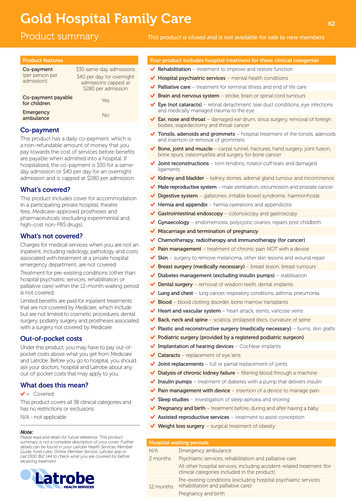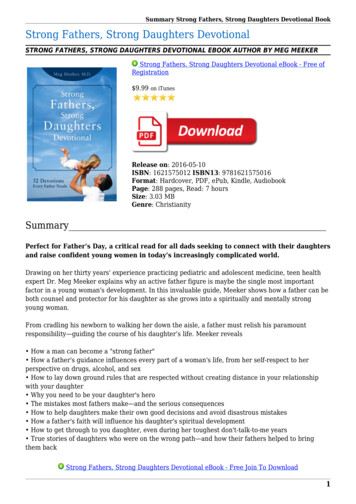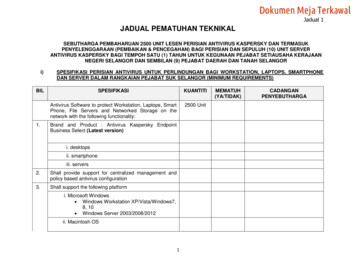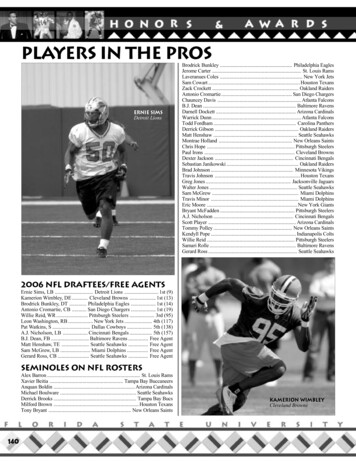
Transcription
PACKERS STRONG.ALL YEAR LONG.2018/2019 ANNUAL REPORT
VISION STATEMENTTo become and remain the standardof excellence against which all otherorganizations in professional sportsare measured.MISSION STATEMENTTo win championships and deliver excellentguest experiences while being guided by ourcore values.
PRESIDENT’S LETTERDear Shareholders:The Green Bay Packers are proud to have played 100 seasons of football and established a rich legacy.Encompassing 13 championships, 26 Pro Football Hall of Famers, an iconic stadium and a unique bond with ourpassionate fans (and community), it is a story of success that endures.As we look forward to beginning the next century of success, we do so with a fresh approach on the field with newHead Coach Matt LaFleur. Matt joins our football leadership team that includes General Manager Brian Gutekunstand Executive Vice President/Director of Football Operations Russ Ball. Overall, I’mvery pleased with the working relationships they’ve built and the direction of our teamunder their leadership. Brian has added many players through the draft and freeagency that will bolster the roster. They join our talented veterans, as well as thesecond-year players who performed well and displayed impressive promise a seasonago. Matt has assembled an impressive coaching staff that has been working hard toprepare the players for the 2019 season.The build-up to exciting football this fall includes the celebration of the Packers’ 100thbirthday as a conclusion of our 100 Seasons celebration. Aug. 11 will be a special day, asit marks the 100th anniversary of the legendary first meeting between Curly Lambeau andGeorge Calhoun held at the old Green Bay Press-Gazette building that launched the team.Making a return this summer are Lambeau Field Live, a traveling exhibit that takes ouriconic stadium around the state, and Packers Experience, a free, three-day interactiveattraction to begin training camp. Both were well attended last summer and are sure to be popular again this year.From a business standpoint, the organization continues to grow revenue at a strong rate and manage ourexpenses well. This year, though, our financial statements will show those positive gains offset by some expensesdue to the changes in the coaching staff and additional expense to fund the concussion settlement with theformer players. These expenses are non-recurring, and do not affect our ability to provide the necessary resourcesto support football operations, the continued enhancement of our stadium, an excellent guest experience andinvestments in the future of the organization and the community.One of our greatest strengths off the field is Titletown. The development west of Lambeau Field continuesto be popular with local residents, and has captured the attention of those outside the community as anattraction for investment, business development and entertainment. TitletownTech launched this year, andthe digital innovation center (on which we’ve partnered with Microsoft) already has sparked promisingbusiness ventures to be developed and grown, as well as investment from fellow pro sports teams’ ownership –the Boston Bruins and New York Mets. Construction on Phase 2 has begun, with exciting residential opportunitiesand office space, and the new offerings are set to join the vibrant area that includes Hinterland, Lodge Kohler andBellin Health Titletown Sports Medicine and Orthopedics.In addition to the community investment through Titletown’s development, the Packers continue to provide supportthrough charitable giving, community events and outreach programs. The charitable impact in the past year throughGreen Bay Packers Give Back, our all-encompassing community outreach initiative, was more than 8 million. Itincluded 1.8 million in grants awarded to nonprofit organizations through the Packers Foundation, with five 250,000 impact grants awarded to the Center for Childhood Safety, Inc., Encompass Early Education and Care, Inc.,Golden House Inc., HSHS St. Vincent/St. Mary’s Hospital Foundation and Give BIG Green Bay.The ongoing support you provide the Packers each year is very much appreciated. I’m looking forward to seeing you atthe Annual Meeting as we prepare for an exciting 2019 season.Sincerely,Mark H. MurphyPresident & Chief Executive Officer1
YEAR INREVIEW2
THE OFFSEASONThe Packers prepared for the 2018 season with a transition taking placein football operations, with Brian Gutekunst taking over for Ted Thompson,who took on a new role as Senior Advisor to Football Operations. Gutekunst’s19 seasons with the Packers gave him unique insight to the organization ashe worked under both Thompson and Ron Wolf before him.“The most important part, specifically in the beginning, is to try to get thevalue of the player right,” Gutekunst said. “As we get further on down,we’ll start to look at scenarios and possibilities for us at each pick, but rightnow, it’s just about getting the value and trying to get to know theseguys as much as possible so we don’t make any mistakes.”He learned the value of the draft-and-develop philosophy over the yearsand certainly planned to use the approach, but also would utilize all meansof roster building.Green Bay’s process is to rate players in their own right but also factorin the team’s needs as part of the overall equation to determine wherethey’d fit as a selection.“Obviously, our foundation’s going to be the draft,” Gutekunst said. “But Ithink (free agency is) an absolute must as an accessory piece. The thing thatI’ve already told our guys is that we’re not going to be signing everyplayer. We’re not going to be able to make that the foundation of ourteam, but we want to be in it and we want to be in the know of everythingthat’s going on and, if it makes sense for us, not to be afraid. We have tobe prepared enough to pull the trigger.”“We try to build the board value-based, but we build it for our own team,not the league,” Gutekunst said. “So those (roster needs) are naturally inplay. It’s important, especially early on, that you’re making sure you’regetting players (evaluations) correct. You have to get the first part rightbefore you can move into the scenarios.”Gutekunst took over a roster that he believed had strong potential.“I don’t think we’re very far away,” Gutekunst said. “There is a substantialamount of work to be done, but I think it can be done shortly. I think therewas a lot of reasons for what happened this year, and there’s certain areasthat needed to play better, and we’re still in the process, I think, of kind ofdissecting some of that and moving forward. But we’re really, really excitedabout the opportunity before us. I think there’s a window here.”Having been involved with drafts for roughly two decades, the processwas nothing new to Gutekunst, only making the final call was a newexperience. In that respect, he knew there would be a lot of voices in theroom, including Ted Thompson’s, and it’s his job to sift through them allto make the best choices.It’s a challenge he clearly looked forward to, and the first round couldn’tarrive soon enough. The Packers’ board was set, and in the final daysthere’s a temptation to continue tweaking it, which Gutekunst referredto as “overcooking.”On the coaching side, Head Coach Mike McCarthy made some changes tohis staff, including bringing back Joe Philbin as offensive coordinator andbringing in Mike Pettine as defensive coordinator.THE NFL DRAFTPettine’s goal was to have Green Bay’s defense back to performing amongthe league’s best, like it was during the first couple seasons of the tenureof Dom Capers, whom Pettine succeeded. Since those years, though, thedefense often has taken a backseat to the offense, a perception McCarthywanted to change in 2018.“It’s got to be a mentality,” McCarthy said. “I’m sick and tired of our defensefeeling like the stepchild. I mean, how many times do you have to tellthem, ‘You’re not the stepchild?’ That’s a blatant statement, and it’snot a cure-all. But it’s definitely a starting point. So, now, with that, you’vegot to give them the opportunity to be better.”Aaron Rodgers had another historic season in 2018, completing 372 of 597 passes (62.3percent) for 4,442 yards and 25 TDs with two INTs for a 97.6 passer rating and was selectedto his seventh career Pro Bowl. He set an NFL single-season record with his interceptionpercentage of .32 (two INTs on 597 attempts), and posted the lowest interception percentagein the league for the third time in his career. He also led the NFL with nine completions of50-plus yards and was tied for the league lead with 16 completions of 40-plus yards.A component of defensive improvement would, of course, come fromnew players joining the mix, including players that join the team viathe draft. Gutekunst said getting to know the college prospects throughinterviews at the Combine is a key part of the process.The team’s personnel staff also had meetings with Pettine and his staffabout the types of players they’re looking to add to Green Bay’s defensethrough the draft.“It’s to get on the same page with them as far as exactly how they want toplay,” Gutekunst said. “That’s really helpful.”Picking 14th in every round, as opposed to the late 20s as a perennialplayoff team, and having 12 total picks would help, too, for a teamGutekunst characterized as not being “very far off” despite all the frontoffice and coaching changes.None of that altered the Packers’ evaluation process in general as they settheir draft board, because building that board as thoroughly as possible isalways the priority.Davante Adams had perhaps his finest year as a pro in 2018, leading the team with acareer-high 111 receptions, the second most in team history, for a career-best 1,386 yards(12.5 average) and a career-high 13 touchdowns on his way to earning Pro Bowl honorsfor the second straight year. He is the only player in the NFL with 70-plus receptions and10-plus TD catches in each of the last three seasons (2016-18) and is No. 2 in the leaguewith 35 receiving TDs since 2016. Adams also leads the league with 26 receiving TDs in thered zone since 2016, seven more than any other player in the NFL.3
Handling the anticipation of draft week can become almost as importantas managing the anxiety during the draft itself. Gutekunst mentioned“conviction” and “discipline” as two additional qualities of Thompson’she admired most amidst all the intensity, and he knew from observationand involvement those attributes were able to shine brightest because thepreparation was so thorough.“I remember how important getting it right from the get-go is, doing thework, getting the board correct,” Gutekunst said, recalling draft lessonshe’s learned over the years. “If you don’t do it back then, it doesn’t matterwhat you do now. You can’t skip steps. You have to do it all. You can’t gointo the weekend and hope to get it right. You have to be ready aheadof time.”On the draft’s opening night, the Packers traded back, traded up andultimately got the playmaker they coveted all along. After swinging dealswith New Orleans and Seattle, Gutekunst used his first selection as GreenBay’s general manager to draft Louisville cornerback Jaire Alexanderwith the 18th overall pick.Jaire Alexander burst onto the scene in 2018, appearing in 13 games with 11 starts, andranking No. 2 on the team with 76 tackles (61 solo) while adding a half-sack, three tacklesfor a loss, an interception and a QB pressure. The 2018 first round draft pick was named tothe PFWA’s All-Rookie team after leading the team with 15 passes defensed, becoming justthe second Packers CB to be honored since 1974.It was the culminating decision on a night in which the Packers’ generalmanager made multiple big decisions in his first draft, first trading back13 spots before trading up nine and picking up an extra first-round pick in2019 from New Orleans along the way.Gutekunst was happy to have added Louisville cornerback Jaire Alexanderto the Packers’ secondary. Alexander was the second pure corner taken inthe draft and one of the fastest overall players with a 4.38 40 time.But Gutekunst got a lot more, even if what he got wouldn’t help the 2018Packers. Getting an extra 2019 first-round pick from the Saints was simplya rare opportunity, knowing he could move back up and still get a player ofequivalent rank on his board.Kenny Clark continued his dominance on the defensive line in his third season, starting inall 13 games he appeared in and recording a career-high six sacks (No. 2 on the team), sevenQB hits and 13 QB pressures. His two fumble recoveries also tied for No. 5 in the league.He was named a Pro Bowl alternate in 2018, and finished No. 3 on the team with 73 tackles(36 solo) despite missing three games.“It was too good to pass up,” Gutekunst said. “Those first-round picks don’tcome around too often.”The Packers added two more defensive players on Day 2 of the NFL Draft –cornerback Josh Jackson and linebacker Oren Burks – to go with first-roundselection Jaire Alexander.The rest of the draft saw the Packers take both offensive and defensive players,as well as a punter, JK Scott, in the fifth round, and a long snapper, HunterBradley, in the seventh. Other picks included WR J’Mon Moore (fourth), OLCole Madison (fifth), WR Marquez Valdez-Scantling (fifth), WR EquanimeousSt. Brown (sixth), and LB Kendall Donnerson (seventh).“I think we helped the Packers,” Gutekunst said at the draft’s conclusion.“It’d be nice to come out of every draft and fill all the holes you think youhave, but that’s never the case,” he said. “You try to take good footballplayers because you really don’t know what your needs are going to become September.”Blake Martinez maintained his momentum as a leader on the defense, leading the teamin tackles each of the past two seasons (158 in 2017 and 147 in 2018), the first Packer to doso in consecutive years since 2012-13, and starting all 32 games over that span. He finishedNo. 3 on the team in 2018 with a career-best five sacks, and added four passes defensedand eight QB pressures.In addition to the players added through the draft, a team’s existingplayers could further contribute as they progress in the system. There’sthe second-year jump, and then there’s the next step.Looking at the Packers’ 2016 draft class, two players unequivocally madethe second-year leap in 2017 that coaches covet and that effectivelylaunches their careers.Defensive tackle Kenny Clark and inside linebacker Blake Martinez werethose two players, building on solid rookie years to become defensivefront-liners in Year 2. They have become core players who will help theteam improve.4Aaron Jones had a landmark second season, ranking No. 1 in the league in yards per carry(5.47 in 2018,) the first Packer to lead the league in the category since the NFL went to a16-game schedule in 1978. His 5.47 yards per carry average was the second-best singleseason mark in franchise history with 100-plus carries. Among running backs with 200-pluscareer attempts, he ranks No. 3 in NFL history with an average of 5.50 yards per carry.
“Your core players are the ones that get you through the rough times, theadverse times,” McCarthy said. “We’re confident those guys can take thenext step.”In free agency, among the players added to the roster were CB TramonWilliams, who spent the 2007-14 seasons with the Packers, DT MuhammadWilkerson and veteran TE Jimmy Graham, who joined the team after eightseasons split between New Orleans and Seattle.“Jimmy is a playmaker. I’ve always admired his game,” said McCarthy.“I thought his video last year, particularly in the red zone, was exceptional.He gives us an excellent target and I think him and Aaron will have agreat relationship.”As the roster continued to take shape during the offseason, QB AaronRodgers acknowledged losing some longtime teammates, including WRJordy Nelson.“It’s tough losing those guys, but that’s the nature of the business,” hesaid. “It’s about change, and you have to remember this is a professionalenvironment. It’s going to happen.“I want to play until I’m 40 and beyond. Many of the guys I’m playing withnow will be moving on at that point, if I’m able to keep playing until then.It’s about cultivating the relationships with the young guys, finding whatthat team chemistry looks like every year – because it changes – and lookingforward to the season.”As the team picked up the pace during organized team activities (OTAs),McCarthy noticed the players were focused.“The energy in the building is significant since the change. I would saythat’s normal,” McCarthy said. “The first OTA, my recollection is it’s alwayshigh energy (with the mindset) ‘it’s about time’ to get out here and playsimulated football.”“ WE’RE GOING TO FIND OUR RHYTHM AT SOMEPOINT DURING THE SEASON AND BE REALLYTOUGH TO STOP.” -AARON RODGERSAs the rookies focused on learning their new playbooks, as well as the insand outs of the NFL, they knew they could look to the veterans for guidance.In the wide receivers room, an obvious mentor was Davante Adams, whohas a unique perspective on how to approach the league. After making hisway into the starting lineup as a rookie in 2014, Adams weathered aturbulent, injury-riddled sophomore campaign before his breakthroughseason in 2016.“I’m quick to use that,” Adams said. “Let them know – especially in toughtimes – that I’ve been where you are right now times a million worse. I’vehad a lot to deal with from outside noise, inside the locker room. In here,people are supportive but people kind of look at you and say ‘when areyou going to step up?’ So you kind of relate to them and give them thestory of how you came along and they see where you’re at now. Like yousaid, it gives you a little more credibility.”As the Packers wrapped up the June minicamp and looked forward totraining camp, McCarthy was pleased with how the offseason went,particularly with the increased number of team (11-on-11) reps that wereworked into OTAs and minicamp.“We were able to accomplish a lot more in a competitive arena with thetype of practices we had,” he said. “I feel really good about where weare today.”The season began in earnest in late July as the Packers openedtraining camp, and the team had a number of questions to answer.To name a few, the right side of the offensive line was not settled,the depth charts at receiver, cornerback and outside linebacker wereundetermined, and a lot of new blood needed to be worked into thespecial-teams equation.But McCarthy liked the chances the 90-man roster that was assembledin the offseason would answer those questions the right way –competitively, and not by default – to set up the Packers to manage theinevitable obstacles that would obstruct their path over the season.“That’s what you want. A competitive environment is clearly one of themost important components of a healthy training camp. It’s a necessity,”McCarthy said.“Training camp is not so much about the first 11 to run out of the tunnel.It’s really those 63 players (53 on the active roster, plus 10 on the practicesquad). That’s the way we’ve always approached it. I’ve used the number77 in reference to the Super Bowl year. It takes that many players to win achampionship.”Rodgers was excited to get started and added there was a “differentfeeling” to the start of camp, with a lot of energy and enthusiasm surroundingthe new defense, and the mix of young talent and veteran leadership hesensed coming together.“With the expectations that we always have on offense,” he said, “we’regoing to find our rhythm at some point during the season and be reallytough to stop.”He was also excited with the approach the defense was taking under thenew coordinator, Pettine, who had addressed the team at the start of camp.“I’ve been around here for 14 years,” Rodgers said, “and that was areally good talk to the team. As an offensive player, to hear a defensivecoordinator get up there and talk about defense the way he did, andgoals and mindset, that was pretty impressive. It gives you a lot of hope.”During camp, any judgments about the team and position groups mustbe made with the proper perspective, but McCarthy liked the early returnsin the defensive backfield.“Our secondary group, we haven’t had that much depth around here inquite some time,” McCarthy said. “We’ve had some outstanding battles,competition going on throughout camp. I’m very pleased with the way oursecondary looks.”On the offensive side, a process observers noted is how Adams, one of theleague’s best receivers, had become a great teacher to the younger passcatchers. He has started passing valuable lessons on to the Packers’ youngreceiving corps, which includes three rookie draft picks in J’Mon Moore,Marquez Valdes-Scantling and Equanimeous St. Brown. Lessons that helearned from Randall Cobb and Jordy Nelson when Adams was a rookiesecond-round pick in 2014.“I feel 100 percent comfortable,” Adams said of the role. “You can go outthere and be a great player, but are you making people around you betteror are you just making yourself better? That’s the best thing for me to goout there and do is pass on what I’ve learned from Cobb or Nelson to theyounger guys.”As the team progressed through the preseason, Gutekunst was preparingfor his first roster cut-down as general manager, feeling good about thequality of depth, and also knowing some tough decisions await.5
“I think we have more than 53 players that are viable players in the NFL,”Gutekunst said.And of that roster, the Packers announced it extended the contract of oneof its most valuable players, Rodgers, through the 2023 season, when thequarterback will turn 40.“This shows, in this contract, there’s a lot of mutual love and respect, andexcitement about keeping this partnership together,” Rodgers said. “Anddoing something I think is pretty cool, being able to start and finish mycareer as a Packer.”The team finished the preseason with a 2-2 record, and looked forwardto getting their 100th season started with a primetime matchup againstarchrival Chicago and their new head coach, Matt Nagy.The Packers had plenty of changes to incorporate, particularly on thedefensive side of the ball with Pettine and a number of new players,including veterans Tramon Williams and Wilkerson along with rookiesAlexander and Jackson.“We’re ready to go,” McCarthy said. “I’m past the changes, and I’m excitedto take the next step with all the new individuals.”THE REGULAR SEASONThe opener lived up to its advance billing, with the Packers pulling out athrilling, 24-23 come-from-behind victory over the Bears. Rodgers broughtthe team back from a 20-point deficit in the fourth quarter. Cobb had a75-yard catch-and-run TD to give the Packers the lead late in the fourthquarter. The performance by the Packers’ QB was even more remarkablebecause he suffered a knee injury and spent time in the locker roombefore returning to the field to retake the helm.Crosby and the team rebounded the next week with a 33-30 win overSan Francisco at home, with the veteran kicker making all four of hisfield goals, including a 27-yarder as time expired to provide the winningmargin, his third game-winning kick in as many seasons.“This week was a grind,” said Crosby. “It was one of the tougher weeks ofmy career, just making sure I didn’t overreact, overanalyze everything.I really did a great job of just locking in and making sure I had goodtempo and I kind of just flushed last week and made sure that if I was calledupon again this week I was going to come through.”After the next week’s bye, the Packers had a stretch of four road games infive weeks.“This is an important stretch in our season,” Rodgers said. “I’m not goingto say it’s going to define our season, but it’s definitely going to shake thingsout when we get on the other side of this and get back home in six weeks,where we’re at in the race and what we’re playing for.”The first game ended with a heartbreaking 29-27 defeat to the Rams at theLA Coliseum. The Packers had a one-point lead late, but a poor punt and akey run by Rams RB Todd Gurley set up the go-ahead field goal. PackersRB Ty Montgomery then fumbled the ensuing kickoff with two minutes left,and the Packers had no last chance.A trip to New England in Week 9 for a primetime battle with the Patriotssaw the Packers fare no better, unfortunately, with the team suffering a31-17 defeat. A fumble early in the fourth quarter took away a chance totake the lead in a tie game.Pettine’s defense stopped the Bears twice on the final series of the gameto seal the victory after a defensive penalty had given Chicago a fresh setof downs.A return home provided a lift as the team defeated the Miami Dolphins,31-12, with RB Aaron Jones providing a boost with a career-best 145rushing yards and two TDs.It was the second-largest comeback win in team history at Lambeau Field.The game later was awarded the “Moment of the Year” at the NFL Honorsceremony in Atlanta during Super Bowl Week.The final two games of the tough, five-game stretch ended in defeats, athree-point loss at Seattle (27-24) and a seven-point loss at Minnesota(24-17).“We’ve had some fun ones in this rivalry,” Rodgers said. “This will be one I’lldefinitely smile about in 10 years.”A home game against the struggling 2-9 Cardinals figured to provide anopportunity to rebound for the Packers with their backs against the wall,but in an uninspired performance, the Packers fell, 20-17, when Crosby’s49-yard field goal attempt went wide right.A Week 2 home matchup against another division rival, the Vikings, awaited.Rodgers knee was the subject of much speculation, of course. If he couldmove well enough, he would play.“The small circle I was moving in Sunday night, if I can get back to that,hopefully a little better than that, without pain, then hopefully I’ll be ableto go,” Rodgers said.6The team couldn’t keep momentum the following week at Detroit,however, and suffered a 31-23 defeat after falling behind 24-0 at halftime.K Mason Crosby was among those who struggled, missing four field goalsand an extra point.Later that evening, Packers President/CEO Mark Murphy relieved McCarthyof his duties as Packers Head Coach.Rodgers did start and played well on a bad left knee in completing 30-of-42for 281 yards and a TD and a 97.4 passer rating, but the team fell short sort of in playing to a 29-29 tie with Minnesota.“This is the worst part of our business,” Murphy said. “Mike’s been atremendous coach for us. He’s also a great man. That makes it even moredifficult to make a decision like this. We all had high expectations we’dbe back competing for a championship and Super Bowl. It’s disappointing.Mike’s had a great run here, but to me it felt like it had run its course.”After a 31-17 loss at Washington the following week, the Packers returnedhome to shut out the Buffalo Bills in a 22-0 win, the team’s first shutoutat Lambeau Field since a 26-0 victory over the Lions in 2009.Offensive Coordinator Joe Philbin was named interim head coach, while asearch for a next head coach would begin immediately with Murphy andGutekunst working collaboratively.The Packers’ defense sacked Buffalo rookie quarterback Josh Allenseven times and turned him over three times during the shutout, withlinebacker Kyler Fackrell logging three fourth-quarter sacks to leadthe way.“The goal is to get the very best coach to get the Packers back to playingchampionship football,” Murphy said. “Our focus now is on finishing theseason strong and then hiring the very best coach we can for the team.”
The team responded the following week with a 34-20 win over theAtlanta Falcons, but dropped two of their next three, including a seasonending shutout loss, 31-0, to the Lions at Lambeau Field to finish 6-9-1 onthe season.With the season concluded, the organization’s focus turned towardcompleting the search for its next Head Coach and the process culminatedwith the naming of Matt LaFleur as the 15th Head Coach on Jan. 8.LaFleur will be entering his 11th year coaching in the NFL and his 18thoverall in coaching, learning under successful head coaches MikeShanahan, Gary Kubiak, Kyle Shanahan and Sean McVay. He served as anoffensive coordinator for both of the past two seasons and a quarterbackscoach for the previous seven years.“He has the unique combination of a quiet confidence but yet a humility,”Murphy said. “I see him having the ability and experience to really makea difference. I think we’ve found a gem in Matt and we’re really excitedabout the future under his leadership.”Corey Linsley continued his stellar play as center, playing every offensive snap for thesecond consecutive season, the only player on the offense to accomplish that feat. Hewas named a Pro Bowl alternate for the first time in his career as he helped the Packersrank No. 2 in the NFL in yards per carry (5.01) and giveaways (15) and No. 1 in rushingfirst-down percentage (29.4).LaFleur referenced the Packers’ championship tradition upon takingthe job.“To be following in the footsteps of Curly Lambeau, Vince Lombardi, MikeHolmgren, Mike McCarthy,” LaFleur said. “It’s truly an honor.”One of LaFleur’s first goals was to finish assembling a coaching staff, andhe definitely had in mind what kind of people he wanted.“I think we’re going to bring a lot of energy every day,” he said. “And I thinkwe’ll be able to connect and reach our players and that’s what I’m mostexcited about. You will not see egos and these guys are going to roll uptheir sleeves and get to work, and I think our players will appreciate that.”LaFleur was looking forward to leading the transition, and working withplayers, notably Rodgers. The team would have to work through somestruggles, however, as they prepare for the new season.David Bakhtiari maintained his status as one of the league’s best left tackles, earningfirst-team All-Pro honors from The Associated Press, the first Packers offensive tackle to earnfirst-team recogni
iconic stadium around the state, and Packers Experience, a free, three-day interactive attraction to begin training camp. Both were well attended last summer and are sure to be popular again this year. From a business standpoint, the organization continues to grow revenue at a strong rate and manage our expenses well.










